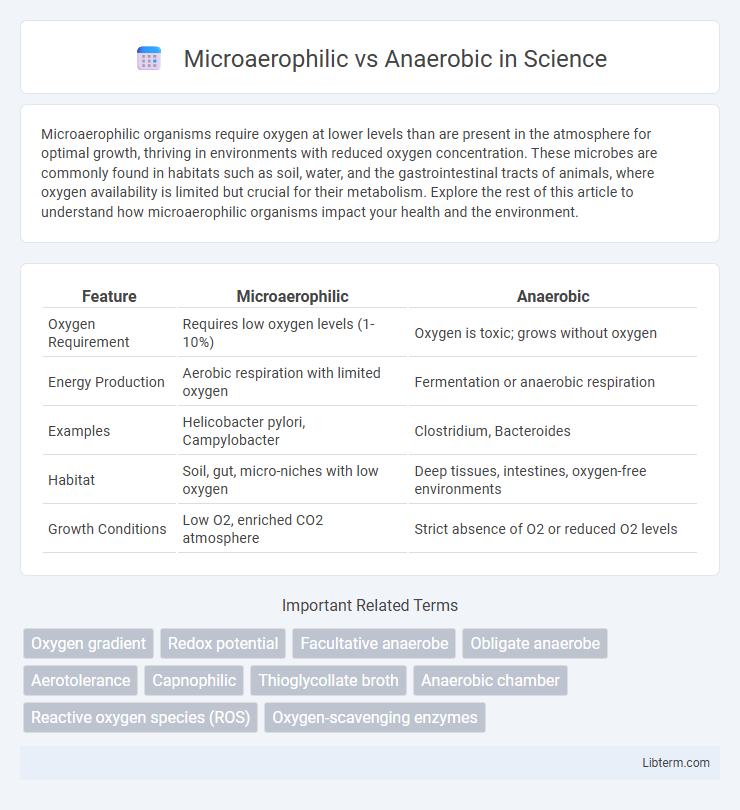Microaerophilic organisms require oxygen at lower levels than are present in the atmosphere for optimal growth, thriving in environments with reduced oxygen concentration. These microbes are commonly found in habitats such as soil, water, and the gastrointestinal tracts of animals, where oxygen availability is limited but crucial for their metabolism. Explore the rest of this article to understand how microaerophilic organisms impact your health and the environment.
Table of Comparison
| Feature | Microaerophilic | Anaerobic |
|---|---|---|
| Oxygen Requirement | Requires low oxygen levels (1-10%) | Oxygen is toxic; grows without oxygen |
| Energy Production | Aerobic respiration with limited oxygen | Fermentation or anaerobic respiration |
| Examples | Helicobacter pylori, Campylobacter | Clostridium, Bacteroides |
| Habitat | Soil, gut, micro-niches with low oxygen | Deep tissues, intestines, oxygen-free environments |
| Growth Conditions | Low O2, enriched CO2 atmosphere | Strict absence of O2 or reduced O2 levels |
Introduction to Microaerophilic and Anaerobic Organisms
Microaerophilic organisms require oxygen at lower concentrations than atmospheric levels, typically between 2-10%, to thrive, whereas anaerobic organisms grow in the complete absence of oxygen, often finding oxygen toxic. Microaerophiles are commonly found in environments such as soil and water interfaces where oxygen is limited, while anaerobes inhabit oxygen-depleted niches like deep soil layers, sediments, or the gastrointestinal tracts of animals. Understanding the oxygen requirements of these microorganisms is crucial for applications in medical microbiology and environmental biotechnology.
Definition of Microaerophilic Conditions
Microaerophilic conditions refer to environments with oxygen levels significantly lower than atmospheric concentration, typically between 2-10%, allowing the growth of microaerophilic organisms that require oxygen but at reduced levels. These conditions contrast with anaerobic environments, which completely lack oxygen, supporting organisms that do not use oxygen for growth and may even find it toxic. Microaerophilic bacteria, such as Helicobacter pylori, rely on this low-oxygen niche to optimize energy production without the harmful effects of atmospheric oxygen concentrations.
Definition of Anaerobic Conditions
Anaerobic conditions refer to environments completely devoid of oxygen, where organisms survive using alternative electron acceptors for respiration. Unlike microaerophilic conditions, which contain low oxygen levels (typically 2-10%), anaerobic settings support obligate anaerobes that cannot tolerate oxygen exposure. These oxygen-free habitats are critical for biochemical processes such as fermentation and anaerobic respiration in ecosystems and industrial applications.
Oxygen Requirements: Microaerophilic vs Anaerobic
Microaerophilic organisms require low levels of oxygen, typically between 2-10%, to survive and grow, as they use oxygen for cellular respiration but are sensitive to high concentrations. Anaerobic organisms thrive in environments devoid of oxygen, employing fermentation or anaerobic respiration pathways that do not depend on oxygen for energy production. The critical difference lies in oxygen tolerance and usage: microaerophiles need minimal oxygen, while anaerobes avoid it entirely, often finding oxygen toxic.
Key Differences in Metabolism
Microaerophilic organisms require low oxygen levels (1-10%) for metabolism and utilize oxygen as the terminal electron acceptor in their respiratory chain, enabling partial aerobic respiration. Anaerobic organisms thrive in oxygen-free environments and rely on alternative electron acceptors such as nitrate, sulfate, or organic molecules, using fermentation or anaerobic respiration pathways. The key metabolic difference lies in oxygen dependency, where microaerophiles use limited oxygen for energy production, while anaerobes completely avoid oxygen, often producing energy via substrate-level phosphorylation.
Habitats and Ecological Niches
Microaerophilic organisms thrive in environments with low oxygen concentrations, such as soil layers, sediments, and the gastrointestinal tracts of animals where oxygen is limited but present. Anaerobic organisms inhabit oxygen-free habitats like deep sediments, wetlands, digestive systems, and anoxic water bodies, often relying on fermentation or anaerobic respiration. Both groups occupy distinct ecological niches that influence nutrient cycling and energy flow in ecosystems with varying oxygen availability.
Clinical and Industrial Relevance
Microaerophilic bacteria, requiring low oxygen levels, are critical in clinical diagnostics for identifying pathogens like Helicobacter pylori linked to gastric ulcers, while anaerobic bacteria, thriving in oxygen-free environments, are significant in treating infections caused by Clostridium species and in anaerobic wound care. Industrially, microaerophilic organisms play key roles in bioprocesses such as waste treatment and fermentation under controlled oxygen conditions, whereas anaerobic microbes are essential in biogas production, anaerobic digestion, and the synthesis of antibiotics like penicillin. Understanding the distinct oxygen requirements and metabolic pathways of these microbes guides targeted therapeutic strategies and optimizes industrial microbiology applications.
Laboratory Cultivation Techniques
Microaerophilic bacteria require low oxygen levels (typically 2-10%) and are commonly cultivated using specialized incubators or gas-generating sachets that precisely control oxygen concentration. Anaerobic bacteria thrive in oxygen-free environments and are cultured using anaerobic chambers, anaerobic jars with gas packs, or reducing media containing agents like thioglycolate to maintain strict anoxia. Understanding these oxygen requirements is crucial in selecting appropriate media and incubation conditions to ensure optimal growth and accurate laboratory identification.
Main Examples of Microaerophilic and Anaerobic Microbes
Microaerophilic microbes such as Helicobacter pylori and Campylobacter jejuni thrive in environments with low oxygen concentrations, typically around 5%. Anaerobic microbes like Clostridium botulinum and Bacteroides fragilis grow in oxygen-free conditions, relying on fermentation or anaerobic respiration for energy production. These distinct oxygen requirements illustrate the metabolic adaptations of microaerophiles and anaerobes to their specific ecological niches.
Summary: Choosing Between Microaerophilic and Anaerobic Approaches
Choosing between microaerophilic and anaerobic approaches depends on oxygen tolerance and metabolic requirements of the microorganisms involved. Microaerophilic environments contain low oxygen concentrations, ideal for bacteria like Helicobacter pylori, while anaerobic conditions completely exclude oxygen, suitable for strict anaerobes such as Clostridium species. Selecting the correct atmospheric condition enhances microbial growth, metabolic activity, and experimental accuracy in clinical and research settings.
Microaerophilic Infographic

 libterm.com
libterm.com